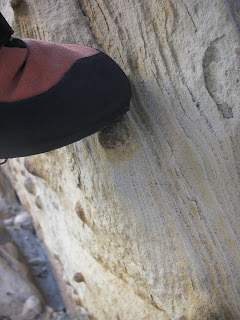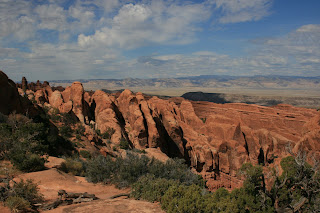Ensimmäinen täysi päivä Zionissa vietettiin seikkaillen. Saimme hankittua puistonvartijoilta luvan kulkea Pine Creek kanjonin läpi. Pine Creek kanjoni on yksi Virgin joen kanjoneista. Se on lyhyt, noin 4 tuntia kestävä reissu, plus tunnin vaellus kanjonin suulta sivilisaation pariin. Varusteisiin kuuluvat kiipeilyvarusteet (miinus mankkapussi), kanjonikengät (käsittämättömän hyvät märällä hiekkakivellä), ja märkäpuku. Kanjoneissa oleva vesi on yleensä alle 10 asteista. Köyden mitan määrää korkein laskeuduttava matka. Pine Creekin loppulaskeutuminen on n. 30 metriä vapaata laskeutumista.
 Anni on the first abseil. The observant of you will notice that the rope is floating. I didn't know that ropes float, but I'm very grateful that they do. We had to work hard to prevent tangles, and if the rope had sunk and got caught around whatever lurked in the canyon pools I'm sure it would have been a recipe for disaster.
Anni on the first abseil. The observant of you will notice that the rope is floating. I didn't know that ropes float, but I'm very grateful that they do. We had to work hard to prevent tangles, and if the rope had sunk and got caught around whatever lurked in the canyon pools I'm sure it would have been a recipe for disaster.
Kanjoneihin on rajoitettu pääsy. Pine Creek on lyhyytensä vuoksi suosittu, ja sinne myönnetään päivittäin enemmän lupia kuin muihin, vaativampiin kanjoneihin. Niinpä mekin päädyimme 'jonottamaan'. Edellämme kulki yksi kokenut nuorimies, joka opasti kahta ensikertalaista tyttöä. Varmistussolmut ja narut olivat tytöillä jatkuvasti sekaisin, jonka lisäksi joka laskeutuminen vaati ponnekasta suostuttelua.
Kanjonin näkymät olisivat todellakin valokuvauksen arvoisia, mutta se oli toivotonta. Tällaiseen reissuun emme uskaltaneet ottaa muita kameroita kuin Tonyn pienen vedenkestävän, jolla ei voi säädellä valotusta tai tehdä juuri muitakaan kikkoja. Kuvat eivät vain onnistuneet. Ylhäältä suodattuva valo tekee kanjonin pohjalla kulkemisen tunnelmalliseksi ja hiukan aavemaiseksi, ja kuvauksellisia kohteita olisi joka kulman takana, mutta niiden nappaamiseen tarvitaan jotain muuta kuin turistikamera. Harmittaa.
Mielenkiintoisin tehtävä koko reissussa oli varmistulaitteen irroittaminen laskeutumisköydestä uimasillaan. Minulta se onnistui suhteellisen hyvin, sillä kannoin selässäni kuivapakkausta, joka kellutti. Tökkäsin jalat kalliota vasten ja sain irrotella narut rauhassa selälläni kelluen. Tonylle homma oli vaikeampi. Lisäksi viimeinen laskutuja joutuu uimaan lammikosta pois vetäen pirun raskasta, märkää köyttä alas kalliolta.
 If this photo just looks black then you can just think, "well that's how they must have felt", but you'd probably do better to adjust your screen. The water in the canyon was frequently waist deep but at times required swimming in. Pulling the ropes from abseiling whilst swimming presented a new challenge that either of us had faced before.
If this photo just looks black then you can just think, "well that's how they must have felt", but you'd probably do better to adjust your screen. The water in the canyon was frequently waist deep but at times required swimming in. Pulling the ropes from abseiling whilst swimming presented a new challenge that either of us had faced before.
Zionissa on tähän vuodenaikaan suhteellisen lämmintä, ja kanjonissa hytisemisen jälkeen olin jo odottanut näkeväni auringon. Viimeinen laskeutuminen lähtee pieneltä kivitasanteelta, aurinkoiselta puolelta kanjonia, ja siellä jouduimmekin odottamaan melko pitkään, jumittuneen varmistusnarun vuoksi. Aurinko päätti pysyä pilvessä, ja tasanteella tuli todella kylmä. Lisäksi kanjonista ilmestyi uusi ryhmä ihmisiä, joten jono vain kasvoi. Vielä jaksoimme kuitenkin hymyillä kameralle.
 As the canyon opened out we were pleased to see the light. You'll notice that we are wearing wet suits, this was pretty essential.
As the canyon opened out we were pleased to see the light. You'll notice that we are wearing wet suits, this was pretty essential.
Viimeinen lakeutuminen oli haastavaa. Teimme koko reissun kiipeilyköysillä, jotka eivät todellakaan ole ideaalisia tähän hommaan. Ensinnäkin, ne imevät vettä ja ovat raskaita käsitellä. Toisekseen, ne joustavat, sillä niiden on otettava vastaan mahdollisesti putoavan kiipeilijän paino. Kanjoneita harrastuksenaan kulkevat käyttävät staattisia, joustamattomia köysiä, jotka eivät ime vettä. 30 metrin abseilaus joustavalla kiipeilyköydellä, ja kitkalaite täynnä hiekkaa, oli kuin olisi istunut valtavan jojon päässä. 20 metrin kohdalla pompotus oli jo huomattavaa, ja hirveän kitkan vuoksi laskeutuminen tökkivää. Tökkiminen vain pahensi köyden pompotusta, ja 30 metrin kohdalla olin jo tulla merisairaaksi. Ylösalasliike oli laajuudeltaan varmasti metrin. En tekisi yhtään korkeampaa laskeutumista dynaamisella köydellä.
 Anni on the last freehanging abseil. The photo is bad because the light was poor. It isn't bad because I'm an incompetant photographer. Honest.
Anni on the last freehanging abseil. The photo is bad because the light was poor. It isn't bad because I'm an incompetant photographer. Honest.
Viimeinen laskeutuminen onnellisesti ohi, lähdimme kanjonista tulevaa puroa pitkin kohti tietä. Loppuvaellus kesti tunnin, jona aikana aurinkokin tuli vihdoin esiin, ja saimme itsemme lämpimiksi. Vaihdoimme kuivapakkauksesta vaatteet ylle, putsasimme kanjonikengistä hiekat, ja painelimme parkkipaikalle. Tehtävä suoritettu!




















































